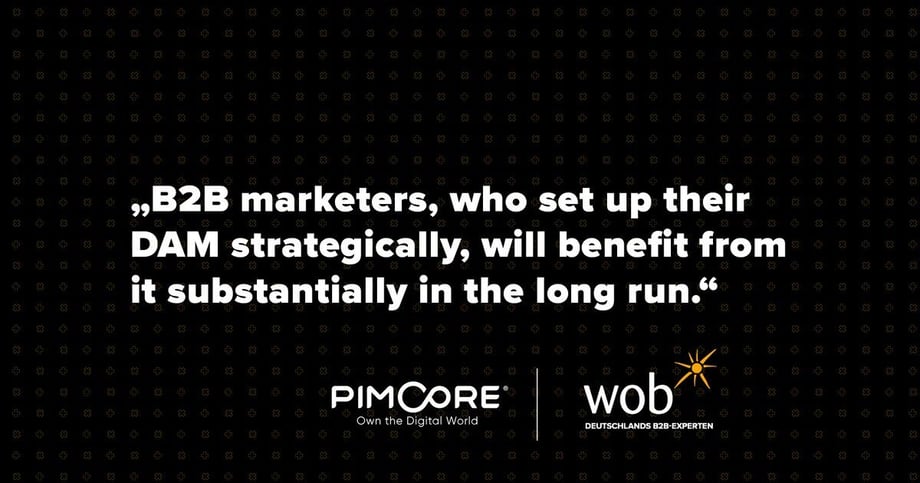
Almost every major company uses a media database for its marketing, communications, and product management. The problem: The heap of files can quickly lead to internal chaos – involving everything from pragmatic share points to bulky Excel charts.
Especially digital files such as images or videos can be crucial to the success of B2B marketing. That's why we want to explain to you how and why digital asset management – often abbreviated as DAM – provides help as a management software. Our partner wob also sheds light on multimedia management from an agency's point of view, and elaborates typical challenges for B2B organizations.
Digital Asset Management (DAM): This is how efficient B2B marketing works.
DAM is a system for media content that helps companies store, manage, and collaboratively use media files in an uncomplicated and centralized way. But what does this mean in concrete terms?
From wob’s point of view, the DAM should be able to fully master the following functions within the company:
- Storage of all assets like images, videos, and other documents in output formats as well as in raw data quality.
- Access to this data with the help of an easy-to-use structural interface with search functions and filtered lists – via direct entry of IDs/URLs or within workflows.
- Essential for this: clean indexing and versioning of all assets – also integration and consolidation of variants and versions where necessary.
- Management of the entire metadata (in addition to names and timestamps also descriptions, copyrights, etc.).
- Deployment of assets and excerpts of the metadata for external guests via a user-friendly interface or by using other common system hubs.
- Responsive output of source files in accordance with end-user demand: on high-resolution monitors with large resolution, on small laptops with less resolution, and for printing with an extra-large number of pixels (keyword: image pipeline).
- Transformation: Raw data is uploaded and automatically deployed in the desired output format.
- Enough performance for processing large amounts of data.
As a B2B agency, wob has been happy and satisfied with the usage of Pimcore for digital asset management for quite some time now. The open-source system offers all the aforementioned multimedia management basics and also adds a variety of useful functionalities for everyday work in B2B marketing.
Of course, B2B marketers most often make use of digital asset management when it comes to website relaunches, the introduction of Web2Print or during collaborations with partners. But marketers, who once decided to set up their DAM strategically, will benefit from it in a more substantial way in the long run.
The best DAM features that are often overlooked particularly in B2B.
Our DAM highlights definitely include the option for integrated image editing (e.g., the quick selection of the right image section or the possibility to make small corrections) and the practical preview of all contents. If you need to manage huge product catalogs with countless product renderings on hundreds of pages, you can use the DAM to make the necessary adjustments quickly and with low efforts – even if you don’t run a typical B2C shop.
If you are looking for the right image for an upcoming landing page or maybe the latest version of a key visual from a summer shooting, you can always find the right asset just by using the search function. Assets of our B2B customers are mostly specially produced photos from shootings or renderings. There is even the possibility of an indirect search with which new colleagues and partners can see products, relevant industries, or other relevant meta data quickly and easily. Of course, the prerequisites here are that all contents have been properly structured and sorted, metadata has to be maintained sufficiently and that a naming convention has been established where it is necessary.
With the help of Pimcore’s specific options for connecting with third-party systems, we have also been able to build a bridge for many B2B customers and their grown system landscapes. The digital asset management capabilities of Pimcore allow, for instance, to administer the image material of a large career website in a centralized location – by pooling together images used for the fields of recruiting or employer branding. In addition, the interface of the system enables the distribution of images from a single source to the aging intranet, to job portals such as Stepstone, and to separate applicant portals. All this together ensures quality, simplifies maintenance routines and saves costs.
Conclusion: Asset management is simple – if you know what's important.
When it comes to asset management, you should take advantage of the know-how of experienced partners, obtain information from numerous online sources, or simply try out systems. DAMs of today usually offer more than you actually need. Hence, it is crucial to find the perfect solutions with which you can optimize the most common workflows and meet your most important demands.



